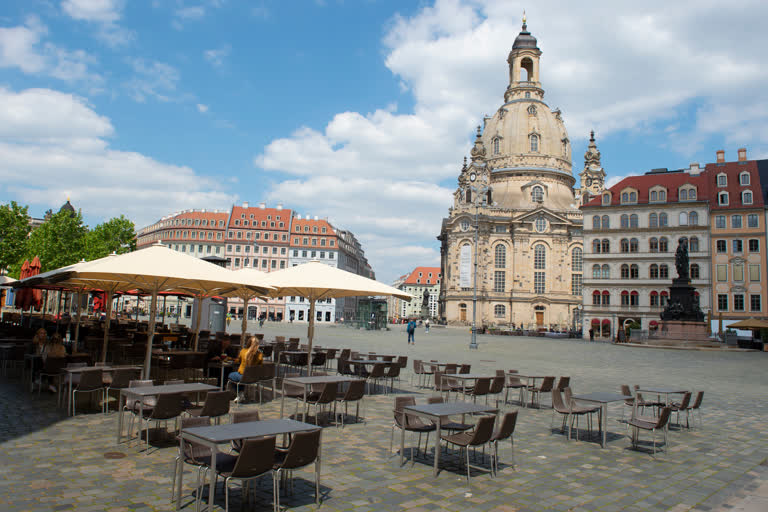Coesfeld: At least 260 workers at this giant slaughterhouse in the city of Coesfeld have tested positive for COVID-19, sounding an alarm just when restrictions imposed to curb the pandemic were slowly being relaxed.
Authorities scrambled to contain the growing outbreak over the weekend, while it emerged many of those infected were Eastern European migrants.
The migrants work for subcontractors who also provide them with accommodation and shuttle buses to work. Constantly together, their infection has spread rapidly.
Another meatpacking company in Germany has also been affected. Authorities have ordered that all the workers must be tested for the virus. The outbreak began shortly before Germany's federal and state governments agreed to trigger an “emergency brake” on relaxing restrictions.
The living and working conditions of the migrant workers in Germany throws light on how much busy urban societies will need to change and adapt to ensure distancing rules are upheld.
Professor Tobias Welte, Head of Pulmonary and Infectious Diseases at the Hannover University School of Medicine is also the President of the European Respiratory Society.
Read more: Know how Chicago morgue copes despite surge in virus deaths
In breathing, we inhale and exhale. When we breathe out, our breath contains aerosol that can carry bacterial or viral droplets. Welte says to calculate safe distancing and how infectious COVID-19 is, they need to know the viral load of these droplets.
He says; "What we do not know is the content of virus, the virus amount in aerosol drops. We do know this for influenza, for rhinovirus (it's a) very high number. It seems to be very low for coronavirus, but it's not clear how many, how dense coronavirus droplets has to be to infect someone."
For large cities like London to get back to work, it's not just the offices, factories and retailers that have to enforce safe distancing.
Transport systems move millions of people around the city and on Wednesday as the UK urged more people back to work it became clear how difficult social distancing can be in densely populated areas.
Also, people don't breathe uniformly, exertion can make you breathe faster and harder, talking or not talking also makes a difference.
Welte says: "It depends on what you are doing so if you are talking a lot, you produce more aerosol if you are coughing you produce more our aerosol, if you are sitting on your desk and you do not talk, you only breathe it's a very small amount."
But whether you're whispering, talking, or shouting you are breathing.
"You have inspiration and expiration and when you expiration, when you pre-expect(orate) there's always some aerosol," says Welte.
An added complication is the incubation period. There's a long time frame between the day you are infected and when you realise you've been infected. So the result of easing lockdowns won't be seen today, or tomorrow but up to fourteen days later.
This makes distancing even more essential. Welte says six feet at least minimise the risk.
He says if you can't do this you should at least wear a mask on a train, especially on the underground. This is not to protect you from COVID, but to stop you transmitting the virus to others.
Also read: 'Smart helmet' introduced at Rome airport to check passengers' temperatures
Welte puts the efficiency of non-specialised surgical masks at between 25 and 50 per cent.
The amount of time you are exposed to someone's breath is also important, the longer the exposure the higher the risk. He also warns that calculating the distance that breath travels are not exact.
"It's not black and white so it's 50 shades of grey if you walk beside someone who is doing nothing than normally breathing your risk is low, but if he is talking, if he is shouting if he is coughing, your risk increases," he says.
Professor Leo Heunks is a respiratory specialist who works in intensive care at the Free University Amsterdam. When he is on a ward he has the protection of PPE.
Asked if social distancing measures are realistic for crowded cities Heunks warns there is currently no alternative. This primary school in France is preparing for the return of it is children, with stringent distancing measures in place.
Top-level football is also planning for a return to the game albeit with far greater limitations.
Welte says arduous contact sports should be considered high risk despite being played outdoors. "It's a little bit higher if you breathe very hard for example, a sportsman in exercise, so this is the reason why I am not so happy with the re-start of the football season because this kind of sports with contact between sportsman and heavy breathing has an increased risk," says Welte.
In a stark warning not to look for easy or quick fixes, the World Health Organisation has warned COVID-19 might never go away but may become an endemic virus within the world community.
Also read: Risk of transmission will potentially go up: WHO
(With inputs from AP)



